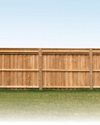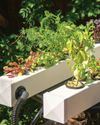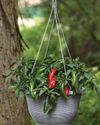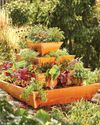
Fences lay out the borders of our property and keep children and pets safely away from the street. But a well-designed fence can be more than just functional a beautiful front-yard fence can make a good first impression.
This is a perfect DIY project, letting you stretch your skills without worrying about load-bearing walls, plumbing, or electricity. One important note: Always check your local requirements before buying materials or starting work.
CONTRASTING MIXED MATERIALS
By combining two or more distinct materials, you can build an attractive fence. Shown here are two styles of mixed-material fences: blended and layered.
BLENDED FENCES, such as this wood and brick example, mix different materials into a single fence. Remove either material and you no longer have a fence. Each part is essential.
LAYERED FENCES are stand-alone fence structures with additional elements. Think of a metal grid fence with horizontal cedar planking. If you removed the wood planking, the metal grid would stand as a fully functional fence. Layered fences can make striking design features; modular construction allows for more creative use of secondary elements to build a unique fence.
POSTHOLE HOW-TO
Designing a mixed-material fence is the fun part. Digging postholes is where the real labor comes in. Here's what you need to know before you dig.
MANUAL VS. MACHINE. For loose soil or a small fence, you can dig the holes by hand. For larger projects or in areas with heavy clay and roots, it's worth renting a power auger. Either way, start by calling 811 to locate underground utility lines. Digging holes is dangerous, even when you think you know your own front yard.
This story is from the July - August 2022 edition of Family Handyman.
Start your 7-day Magzter GOLD free trial to access thousands of curated premium stories, and 9,000+ magazines and newspapers.
Already a subscriber ? Sign In
This story is from the July - August 2022 edition of Family Handyman.
Start your 7-day Magzter GOLD free trial to access thousands of curated premium stories, and 9,000+ magazines and newspapers.
Already a subscriber? Sign In

7 Bicycle Maintenance Tips
Keep your bike in tiptop shape and ride safe!

SETTING FENCE POSTS WITH EXPANDING FOAM
Any fence builder knows you need strong posts for a strong fence, and that means backfilling the postholes with a dense, hard material other than dirt.

PEBBLE MOSAIC STEPPING STONES
COLLECT SOME RIVER ROCK AND MAKE YOUR OWN UNIQUE STEPPINGSTONE PATH

EARTH-FRIENDLY WEED KILLERS
HEALTHIER CHOICES FOR HUMANS AND THE ENVIRONMENT

DIY! HYDROPONIC GARDEN
FRESH VEGETABLES AT YOUR FINGERTIPS

GROW MINI VEGETABLES
GROW A GARDEN IN A TINY SPACE!

BUILD A VERTICAL GARDEN
TIME TO GROW UP!

MODERN WATER FOUNTAINS
A SPLASH OF PEACE FOR YOUR PATIO

9 ALTERNATIVE USES FOR SAWDUST
Every fully stocked wood shop has a table saw. You can usually find a pile of sawdust under it, even if it's used only occasionally. If a shop has a belt sander or band saw, there's probably another pile of finer sawdust under that. Even people without stationary tools have sawdust accumulation on their workbenches.

INSULATE WITH FOAM
IT'S A GREAT ALTERNATIVE TO FIBERGLASS